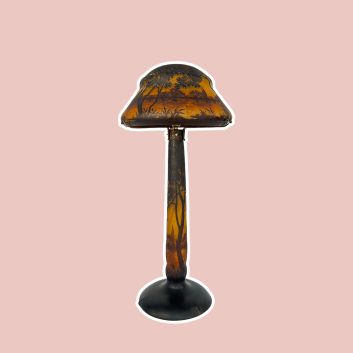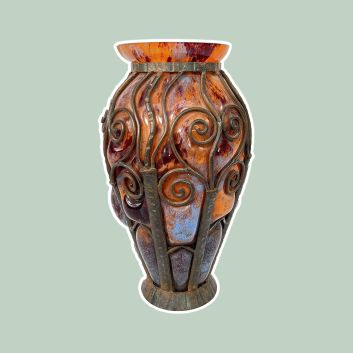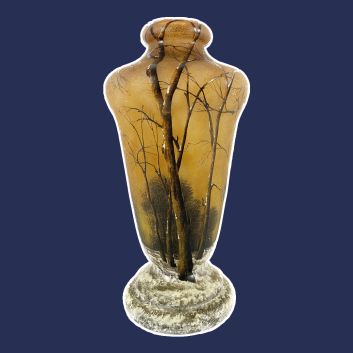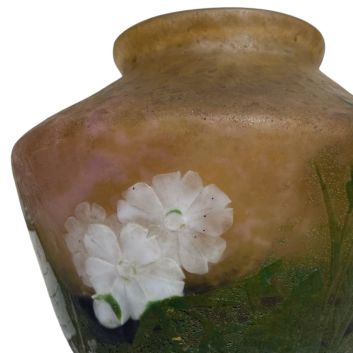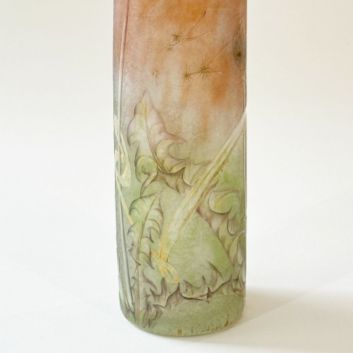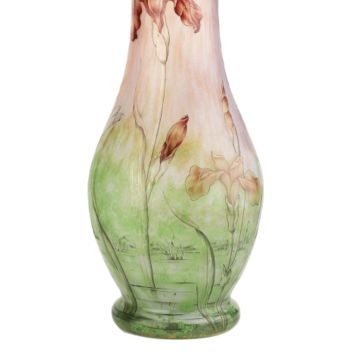Valeur et cote des lampes Daum
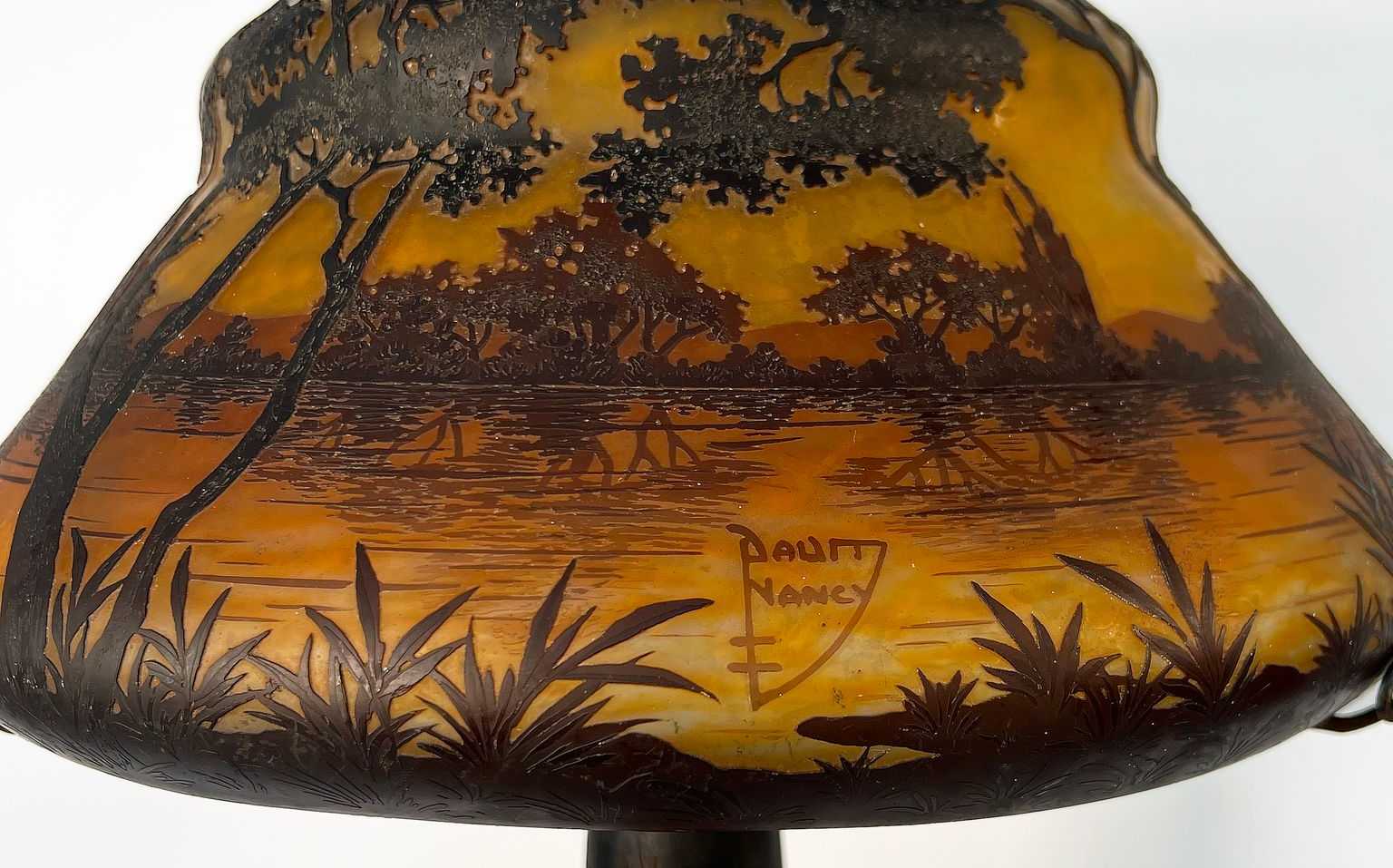
Si vous détenez une lampe réalisée par la verrerie Daum ou d’après, et que vous souhaitez connaître sa valeur, nos experts et commissaires-priseurs agréés par l’État vous offriront leurs services d'expertise.
Nos spécialistes s’emploieront à réaliser une expertise gratuite de votre œuvre, et vous transmettront une estimation précise de sa valeur sur le marché actuel.
Par la suite, si vous désirez vendre votre œuvre, nous vous orienterons vers le meilleur dispositif possible pour en obtenir un prix optimal.
Cote et valeur des lampes Daum
Daum est un verrier français assez connu des amateurs de lampes en cristal. Si vous en possédez une, sa valeur est peut-être supérieure à ce que vous pensez. Sur le marché de l’art, les prix des lampes Daum peuvent être très élevés au marteau des commissaires-priseurs.
Leurs lampes sont particulièrement prisées et le prix auquel elles se vendent sur le marché de l’art s’échelonne entre 350 € et 350 670€, un écart assez conséquent, mais qui en dit beaucoup sur la valeur qui peut être attribuée aux lampes Daum.
En 2019, une lampe de table « nénuphar », réalisée en collaboration avec Jacques Majorelle a été vendue à hauteur de 149 700€ tandis qu’il était estimée entre 105 700 et 158 500€ par Christie’s, l’estimation haute a donc quasiment été atteinte.
Ordre de valeur allant d’une œuvre simple à la plus prestigieuse
Type de lampe | Résultat |
|---|---|
Veilleuse - lampe de chevet | De 350 à 149 700€ |
Lustre - suspension | 450 à 29 500€ |
Luminaire classique | De 450 à 350 670€ |
Réponse en - de 24h
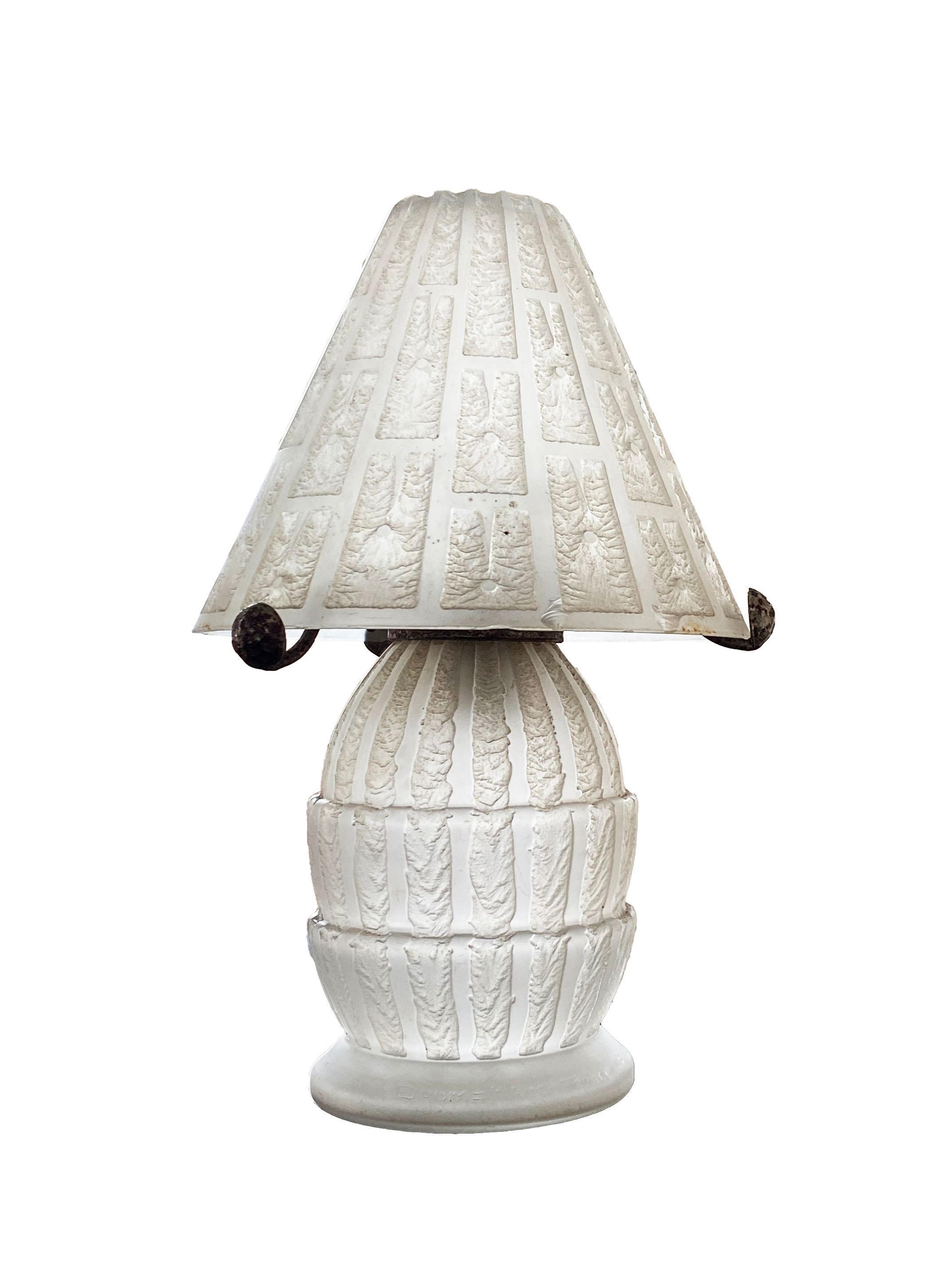
Style et technique de la maison Daum
Le style et la technique de la verrerie Daum incarnent à la fois l'élégance de l’Art Déco et un savoir-faire artisanal unique.
Fondée par Jean Daum près de Nancy après la guerre contre la Prusse, la maison Daum s’établit comme l’une des figures majeures de l'art verrier français, s'inspirant de l'œuvre d’Émile Gallé.
Bien plus qu’une simple verrerie, Daum devient rapidement un atelier de création artistique, alliant finesse et innovation.
Jean Daum, animé par le désir de perpétuer l’art du verre, met en place des techniques pionnières qui marient les procédés traditionnels avec des recherches esthétiques novatrices.
Les pièces de Daum, souvent influencées par les formes naturelles et les motifs végétaux caractéristiques de l’Art nouveau, évoluent progressivement vers les lignes plus géométriques et structurées de l’Art Déco, tout en conservant une dimension poétique.
La maison se distingue par l'utilisation de la pâte de verre, une technique complexe qui permet d'obtenir des nuances et des reliefs saisissants, et qui nécessite une maîtrise parfaite de la matière.
Cette méthode, qui consiste à fondre des fragments de verre colorés, donne aux œuvres un éclat particulier et une texture veloutée, créant des effets de lumière qui magnifient les détails.
Sous la direction de ses fils Auguste et Antonin, Daum perfectionne également la gravure à l’acide et l’incrustation de couleurs, des techniques qui permettent de créer des pièces aux motifs raffinés et aux contrastes subtils.
L’innovation technique, alliée à une vision artistique audacieuse, propulse Daum au rang de référence mondiale dans le domaine du verre et du cristal, où chaque création devient une œuvre intemporelle, fruit d’une fusion harmonieuse entre tradition et modernité.
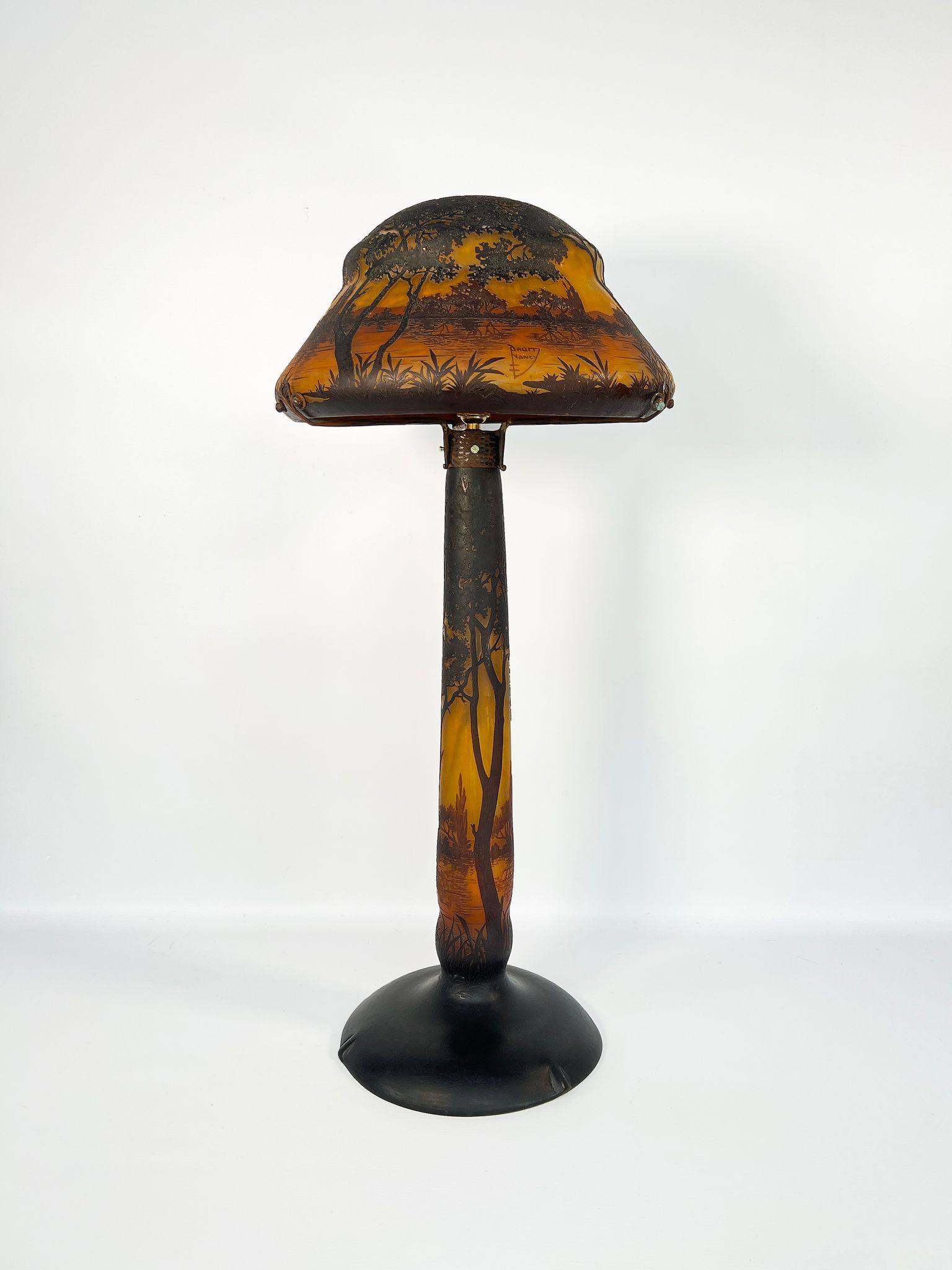
L’histoire de la verrerie Daum
L’histoire de la verrerie Daum est celle d’une entreprise familiale visionnaire qui s’est imposée comme un pilier de l’art verrier français.
Fondée par Jean Daum (1825-1885), verrier passionné, la maison Daum est aujourd’hui reconnue mondialement pour son excellence et son innovation.
Initialement notaire dans le nord de la France, Jean Daum change de cap après la guerre contre la Prusse, s’installe à Nancy et y fonde une verrerie en 1878.
Dès le départ, il intègre son fils Auguste dans l’aventure, conférant à l’entreprise un esprit familial qui restera l’une de ses marques de fabrique.
À la mort de Jean, Auguste Daum prend la tête de la verrerie et s’entoure de son frère Antonin, qui apporte une dimension artistique à la maison. Sous la direction artistique d’Antonin, la verrerie Daum se distingue par des créations audacieuses et raffinées.
Ce dernier maîtrise diverses techniques de verrerie, dont la décoration à l’acide, le verre multicouche et la gravure à la roue, autant de procédés qui permettent de donner aux pièces un relief et une profondeur inédits.
Antonin Daum signe de nombreuses œuvres, et son nom devient un gage de qualité et de créativité, prisé des collectionneurs du monde entier.
L’arrivée de talents comme Jacques Grüber, premier artiste engagé par la verrerie, marque un tournant décisif. Grüber se charge de concevoir des pièces uniques et élégantes, contribuant à l’identité artistique de la maison.
En 1893, la manufacture fait sensation à l’Exposition universelle de Chicago, une première reconnaissance internationale. Fort de ce succès, Daum expose ensuite dans toute la France et accumule les distinctions.
À l’Exposition universelle de 1900, la verrerie Daum, aux côtés de la maison Gallé, est récompensée pour l’excellence de son savoir-faire, affirmant sa place dans le monde de l’art.
L’équipe artistique s’enrichit de nouveaux talents comme Henri Bergé, Émile Writz et Amalric Walter, chacun apportant sa sensibilité et son expertise.
Ensemble, ils façonnent un univers esthétique unique, où la matière se fait poésie, et contribuent au rayonnement artistique de la verrerie Daum bien au-delà des frontières françaises.
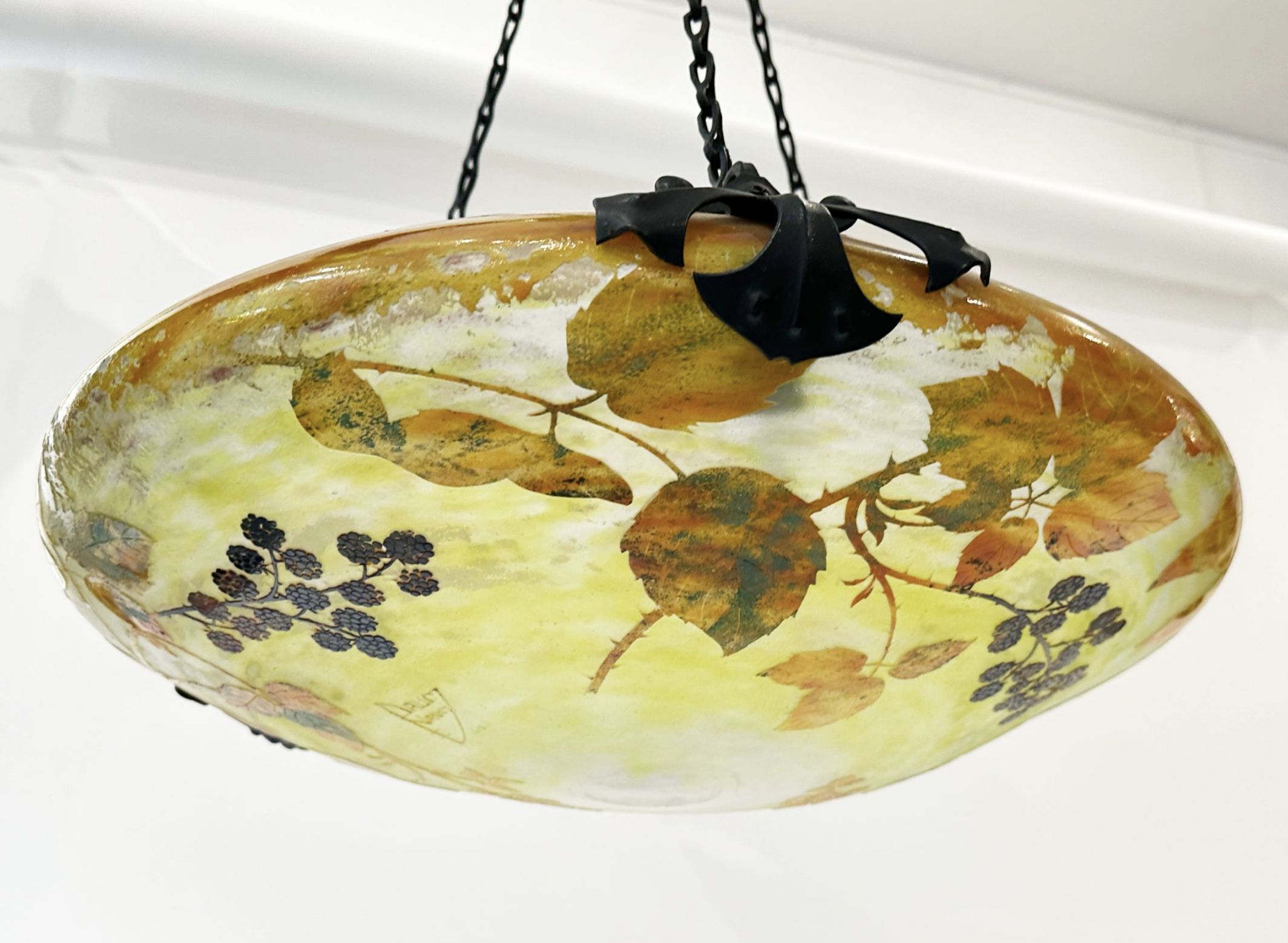
Focus sur une lampe Daum et Majorelle à décor de feuillage
Cette lampe signée Daum et Majorelle traduit parfaitement l’élégance subtile et organique de l’Art Nouveau. Ici, les motifs de feuillage automnal s’animent sous une lumière douce, capturant l’essence d’une nature apaisante.
Le choix de teintes chaudes, où le jaune doré côtoie des touches de brun cuivré, évoque une forêt baignée de lumière, créant une atmosphère chaleureuse et enveloppante.
La technique de gravure à l’acide permet de donner vie aux détails des feuilles, aux nervures minutieuses et aux contours précis des baies, tandis que la texture légèrement en relief confère au décor un réalisme saisissant.
Cette maîtrise technique souligne l’héritage de Daum dans l’art du verre et du cristal, où chaque nuance et chaque forme semblent s’intégrer naturellement dans la matière.
Le support en fer forgé, orné de courbes délicates et solidement travaillé par Majorelle, complète cette œuvre d’art avec une élégance discrète mais affirmée. La symbiose entre le verre et le métal traduit la recherche d’harmonie chère aux artisans de l’époque.
À travers cette lampe, la maison Daum et Louis Majorelle nous offrent une véritable ode à la nature.
L’objet devient un hommage à l’automne, à ses couleurs, à sa poésie, captant la lumière et la diffusant avec douceur. Un exemple d’un savoir-faire qui marie avec délicatesse l’art et la fonctionnalité.
Initiation à la verrerie Art Nouveau : Jean-François Bourriaud
Le succès des lampes Daum
Le succès des lampes Daum repose sur un équilibre parfait entre innovation technique et raffinement esthétique, qui fait de chaque pièce un objet convoité.
Dès l’ouverture de la manufacture en 1878, Jean Daum prend pour modèle l’approche d’Émile Gallé, pionnier de l’Art Nouveau, et adopte la technique de la décoration à l’acide pour donner vie aux créations Daum.
Ses fils, Auguste et Antonin, perpétuent cet héritage, tout en innovant avec l’utilisation de la pâte de verre, matière précieuse permettant d’obtenir des reliefs saisissants, presque sculpturaux, qui se prêtent admirablement aux motifs stylisés.
Chaque série de lampes Daum est réalisée en édition limitée, avec un nombre d’exemplaires réduit (200 à 300 au maximum), ce qui renforce leur rareté et leur valeur sur le marché des enchères.
La diversité des modèles proposés par la verrerie témoigne d’une inventivité sans cesse renouvelée : des lampes de table aux veilleuses, en passant par les suspensions, les lustres ou encore les lampadaires à poser.
Malgré cette variété, toutes les créations Daum demeurent ancrées dans le style Art Déco, avec des lignes sobres et élégantes qui s’adaptent harmonieusement aux intérieurs contemporains comme classiques.
Parmi les pièces les plus recherchées figurent celles issues de collaborations prestigieuses, notamment avec Jacques Majorelle.
Ces lampes, signées de cette association créative, sont particulièrement prisées aux enchères, atteignant des records de vente et incarnant l’essence même du savoir-faire et de la vision artistique de la maison Daum.
Reconnaître la signature sur un produit Daum
Toutes les lampes produites par la verrerie Daum ne sont pas signées. De surcroît, comme plusieurs artistes ont travaillé et parfois collaboré pour la manufacture, le vase (ou la lampe) peut être signé d’un autre nom alors qu’il a été produit par la verrerie Daum. C’est pourquoi il est important de faire estimer vos pièces.
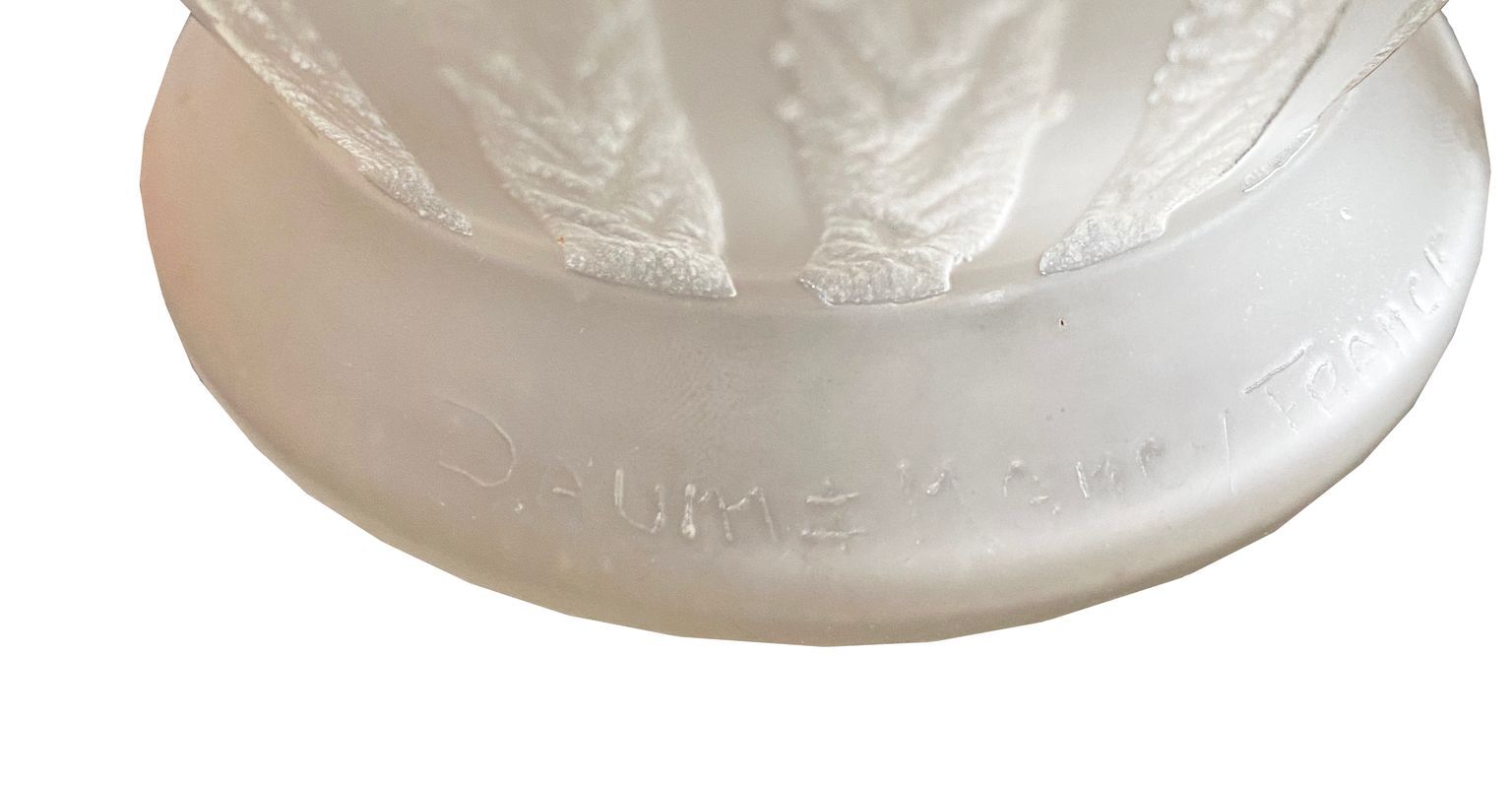
Réponse en - de 24h
A découvrir dans la même thématique
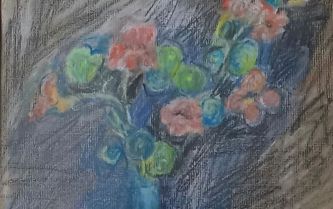
Cote et valeur des oeuvres, dessins, peintures de Blanche Ho...
Blanche Hoschedé Monet est une artiste impressionniste du XXème siècle qui a produit des dessins et huiles sur toile ayant de la valeur aux enchères.
En savoir plus >
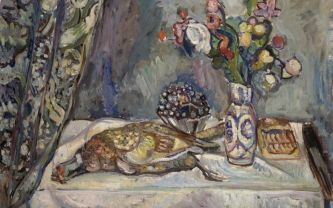
Cote et valeur des oeuvres, dessins, peintures de Pinchus Kr...
Pinchus Kremegne est un artiste russe de l'école de Paris qui a produit des dessins et huiles sur toile ayant de la valeur aux enchères.
En savoir plus >
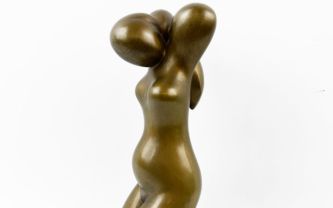
Cote et valeur des sculptures, tableaux, dessins de Baltasar...
Baltasar Lobo est un artiste figuratif espagnol du XXème siècle, qui a produit des sculptures et autres oeuvres cotées et qui ont de la valeur.
En savoir plus >
Site sécurisé, anonymat conservé
Commissaire-priseur et expert agréé par l'État
Estimations gratuites et certifiées
